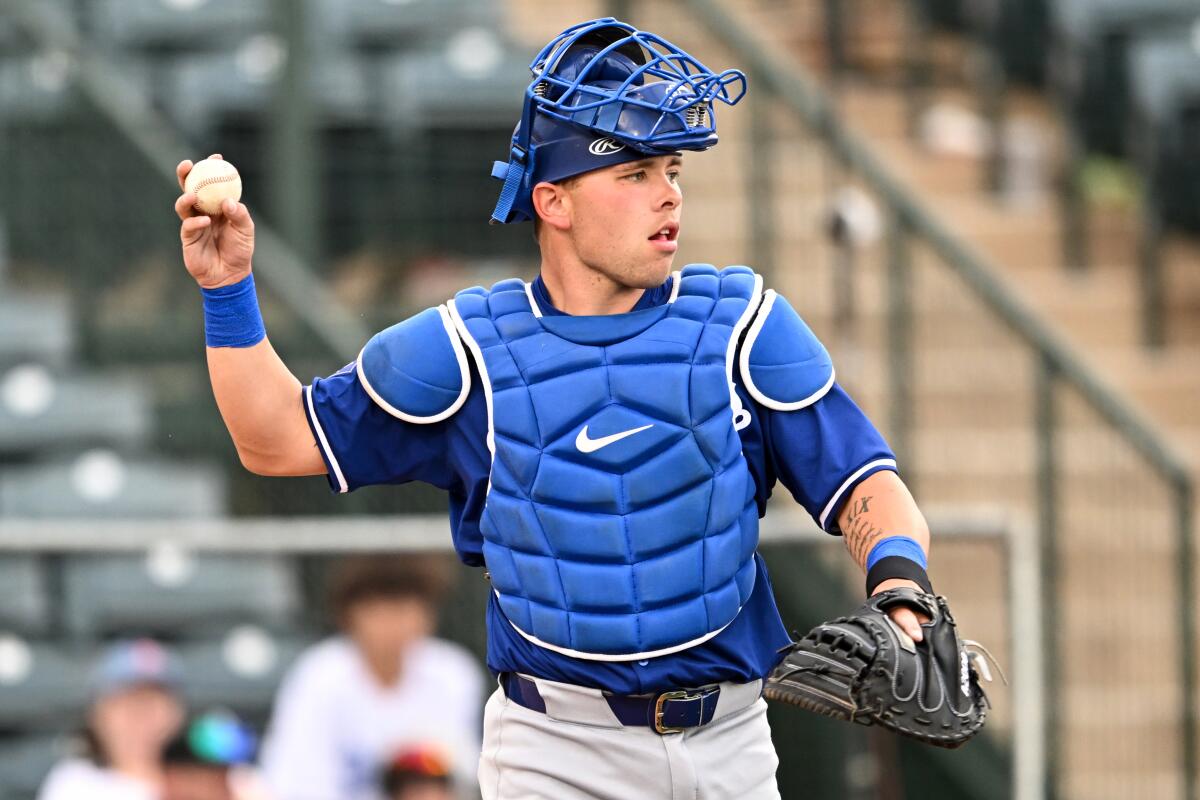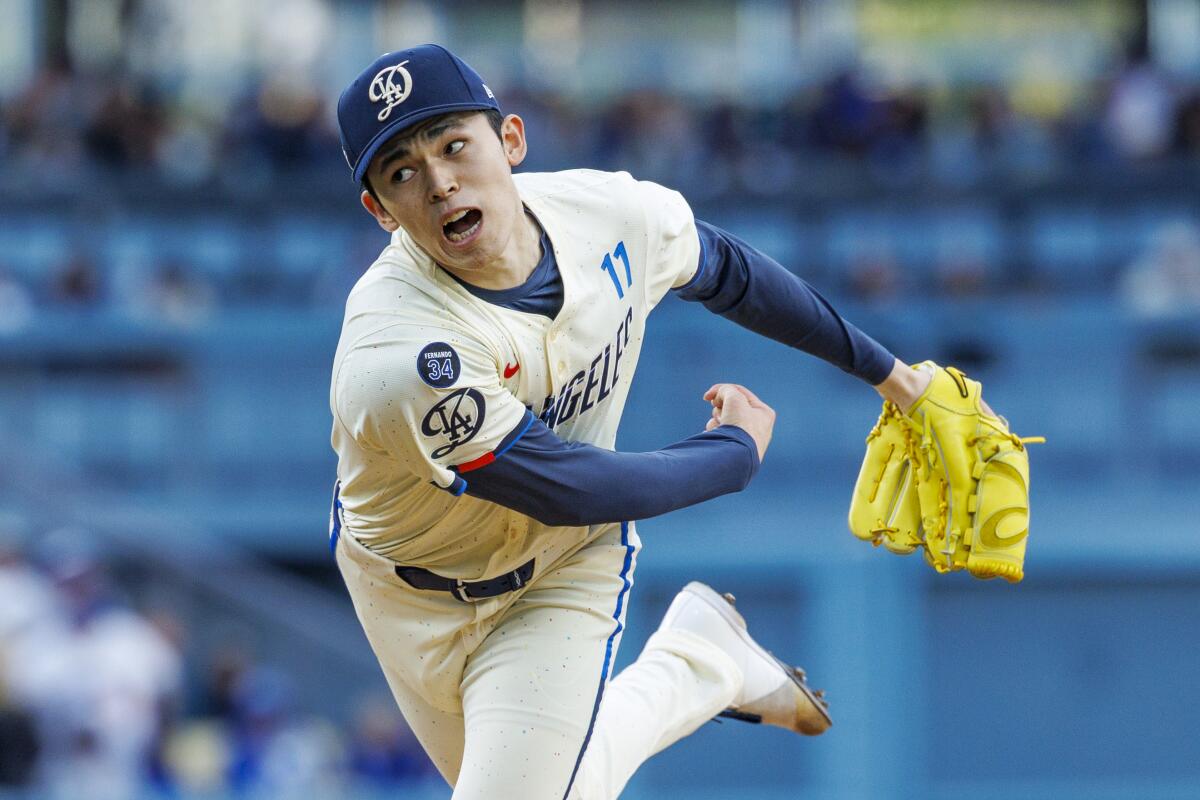Dodgers call up catcher Dalton Rushing, designate Austin Barnes for assignment

- Share via
Dalton Rushing’s time has arrived.
And it came at the expense of the Dodgers’ longest-tenured position player.
In a major midseason roster shuffled Wednesday, the club called up Rushing, the big-hitting catcher who was ranked as the top prospect in their organization, and designated backup catcher Austin Barnes for assignment, closing the book on Barnes’ two-time title-winning tenure in Los Angeles while opening a new one on Rushing’s highly anticipated MLB career.
It’s no surprise that Rushing, a 2022 second-round pick out of the University of Louisville, is getting a crack at the majors. Over four minor-league seasons, the catcher slugged his way through the farm system by batting .277 with 54 home runs, 185 RBIs and a .931 OPS. After winning the organization’s minor league player of the year award last year, Rushing opened this season in triple-A Oklahoma City, hitting .308 in 31 games and ranking seventh in the Pacific Coast League with a .938 OPS. Even back this spring, manager Dave Roberts said Rushing’s bat was big-league ready.
“Pretty excited, obviously,” Rushing said from the Dodgers Stadium dugout on Wednesday afternoon, fresh off his first batting practice after arriving in the Southland in the afternoon. “Any person is gonna be excited in this situation. I think the biggest thing is just get around these guys and be as comfortable as possible. Understand that it’s still the same game, and I get to play with some of the best players in the world.”
Dalton Rushing won 2024 Minor League Player of the Year and has earned positive reviews from the Dodgers, but he is still working to earn his MLB debut.
But the Dodgers’ decision to effectively part ways with Barnes represents more of a surprise — albeit, understandable — decision.
Barnes, 35, was in his 11th season with the Dodgers, his time with the team going back farther than all other current Dodgers except for friend and battery mate Clayton Kershaw. He had just had a $3.5-million club option picked up by the team in the offseason. And he was a two-time World Series champion — behind the plate for their drought-snapping 2020 title — with veteran expertise at calling games, and above league-average metrics for framing pitches and blocking balls in the dirt.
However, Barnes was also batting just .214, with a .514 OPS that ranked ahead of only Chris Taylor among Dodgers hitters with at least 20 at-bats. His arm had become a liability behind the plate, throwing out just one of the 16 runners who attempted a steal against him. And unlike the left-handed-hitting Rushing, he didn’t form an ideal platoon partner with starting catcher Will Smith, with both backstops batting from the right side.
“This was certainly a tough conversation,” Roberts said. “Austin is a Dodger for life. He helped us win the championship. Caught the last pitch in 2020, in the World Series, and he’s done a lot of great things in the community, for the Dodgers, for myself, personally.
“I just think that for us right now, with what Dalton Rushing is doing on the performance side, it’s an opportunity to challenge him, expand his growth, give him an opportunity to log some major league games and essentially give him some runway.”

Indeed, Rushing doesn’t figure to return to the minors anytime soon.
By cutting Barnes, the Dodgers have essentially named Rushing their new backup catcher — a role in which he might only start two to three times per week, but could benefit from the exposure he will get around the big-league coaching and pitching staffs.
“In one sense, to not take at-bats every day, you could see some downside,” Roberts acknowledged. “But I think that us talking internally, having him here in this environment, around our pitchers, around our coaches, understanding how we game plan, understanding major league hitters, and then to most importantly log major league at-bats — I think just net sum, it was more positive.”
Entering this year, Rushing’s long-term future with the Dodgers was in some question, given that Smith signed a 10-year, $140-million contract extension in March 2024.
With the starting catcher’s job seemingly locked up for the next decade, the Dodgers experimented with Rushing at first base and left field last season.
But, while Rushing has continued to play those other two positions occasionally with Oklahoma City, the Dodgers’ front office made it clear they still saw his future foremost as a catcher — so much so, they had him lead catcher’s meetings during spring training, in what was a preview of what he’ll now experience with the Dodgers’ meticulous game-planning process.
Hernández: Roki Sasaki’s shoulder issue leaves Dodgers in a familiar and problematic position
Columnist Dylan Hernández writes that Roki Sasaki can still become everything the Dodgers envisioned, but his path to greatness has become infinitely more complicated.
“They were very beneficial as far as finding my process, I think that’s the best way to put it,” Rushing said of the spring meetings. “Game planning can be very overwhelming at times. Some people can take it too literal. Some people can be very to the point. For me, just finding that happy medium of making sure I know every little detail that I need to.”
If Rushing’s game translates to the majors, it could give the Dodgers an ability to more carefully manage Smith’s workload, too. The past couple years, Smith’s numbers have tailed off in the second half of the season. Already this season, Roberts said he had “been a little bit on the conservative side” with Smith’s playing time, starting him behind the plate in 30 of the club’s first 42 games.
Ideally, with more of an impact bat to call upon on Smith’s days off, the Dodgers could try to find him more rest. Conversely, on the days Smith starts, the Dodgers will have Rushing as a bench option for late-game pinch-hit situations.
“The bat has always played, that’s always been his carrying tool,” Roberts said of Rushing. “The receiving has gotten much better. The arm strength is there. The relationship with the pitchers has continued to grow. And all the reports that we’ve got on the triple-A side, just improvement all around. And so with the maturity that he has, the performance, we just felt that it was the right time.”
“Unfortunately,” Roberts added, “we’ve got to move on from a player that’s such a professional like Austin Barnes.”
Sasaki discusses shoulder

A day after landing on the injured list with a shoulder impingement, rookie Japanese pitcher Roki Sasaki told reporters Wednesday that he had been battling shoulder discomfort in each of his last two starts — but didn’t alert the Dodgers’ coaching staff until recently because of the other injuries their rotation was already facing.
“Just looking at the team and where the team situation was, I wanted to really help the team in any way, shape or form,” Sasaki said through interpreter Will Ireton. “With that being said, the last two outings haven’t been up to par to where I want it to be.”
The last one, at least, certainly wasn’t.
After earning his first career victory in a five-inning, three-run start in Atlanta earlier this month, Sasaki was knocked around for a season-worst five runs over four innings in Arizona last week — an outing in which his diminished fastball velocity and inconsistent command came to a head after yielding two first-inning home runs.
Sasaki, who has averaged just 96 mph with his heater and has been as low as 92-93 mph, wasn’t sure if his shoulder problem was “the main factor” in his velo drop or his accompanying command issues. But he acknowledged his stint on the injured list will also afford him time to work through any delivery issues that might have also been plaguing him.
Sasaki dealt with a similar shoulder issue while pitching in Japan last year, but said this recurrence is less serious.
“[It was] not necessarily like pain,” he said. “It was just not the ideal way that I want my shoulder to move.”
Sasaki has been shut down from throwing for now, and will have his shoulder monitored day-to-day. His timeline to return to the active roster remains unclear.
Other injuries
Emmet Sheehan, the former Dodgers prospect who been out since the start of last year because of Tommy John surgery, threw live at-bats Wednesday at Dodger Stadium against Tommy Edman and Teoscar Hernández, who continue to work their way back from injuries.
Edman and Hernández will likely not be back until next week, Roberts said. Sheehan, meanwhile, continues to trend in a positive direction and could be “a little sneaky pick to click,” Roberts declared, when he returns later this season.
In other injury news, Blake Snell was cleared to begin a throwing progression Wednesday and played catch from 60 feet. Snell, who has been out more than a month with shoulder inflammation, had his throwing program pushed back last week after feeling continued shoulder discomfort.
More to Read
Are you a true-blue fan?
Get our Dodgers Dugout newsletter for insights, news and much more.
You may occasionally receive promotional content from the Los Angeles Times.








